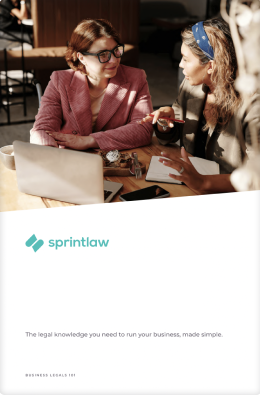Contents
If your business deals with goods or services and is thinking about registering a trademark, it is important that you understand the trademark classes in Australia.
As a business owner, entrepreneur or innovator, knowing how to correctly register your trademark is imperative.
There are 45 different trademark classes in Australia, let’s break them down.
First Up, What Is A Trademark?
A trademark is a way to distinguish your business’s unique goods and services.
A trademark is a tool to protect your business’s brand and ensure that it is distinguished from any other products or services.
The purpose of a trademark is to ensure that you have exclusive rights to use, license and sell that trademark.
Contrary to popular belief, a trademark is not just a logo. A trademark can be a:
- Logo
- Letter
- Number
- Word
- Phrase
- Sound
- Smell
- Shape
- Picture
- Movement
- Type of packaging
A trademark can also be a combination of the above.
Some other important things to note about trademarks include:
- A trademark is not a business name, company name or domain name.
- A trademark is not a design.
- For example, the flying kangaroo on the tail of Qantas’ tail is a trademark where
- Trademarks must be actively used or else they may be removed.
- This avoids people registering trademarks just for the sake of doing so.
Some examples of popular trademarks include:
- The Vegemite logo
- The R.M. Williams logo
- The ABC logo
- The Weetbix cereal box
- The Google Logo
- The Nike tick
Trademark Classes in Australia
Australia has 45 trademark classes that are broken down into 2 categories:
- Goods: Classes 1 – 34
- Services: Classes 35 – 45
In accordance with the Intellectual Property Australia, each trademark class is broken down below.
Goods
| Class 1 | This class applies to chemicals for use in: • IndustryScience • Photography • Agriculture • Horticulture • Forestry |
| Class 2 | This class includes: • Paints • Varnishes • Lacquers • Other preparations that are used as coatings either for decorative or protective purposes |
| Class 3 | Class 3 includes: • Cosmetics • Personal hygiene (for non-medical purposes only) • General cleaning • Polishing preparations |
| Class 4 | Class 4 relates to the following goods: • Primarily industrial oils • Greases • Lubricants • Fuels • Illuminating substances • Scented and unscented candles and wicks |
| Class 5 | A lot of goods are in Class 5, particularly those relating to: • Pharmaceutical • Veterinary and • Sanitary preparations • Baby diapers • Dietary supplements • Infant food and beverages • Sanitary items (for medical purposes) • Disinfectants |
| Class 6 | Class 6 relates to unworked and semi-worked common metals, alloys and ores. |
| Class 7 | Class 7 includes: • Power-driven machines • Machine tools • Motors • Engines |
| Class 8 | Class 8 includes hand-held tools to perform tasks such as tools used for: • Drilling • Shaping • Cutting • Piercing Example include: • Hammers • Drills (not powered by electricity or any other power source) • Chisel |
| Class 9 | This Class includes: • Electronic equipment • Instruments for scientific research • Information technology • Safety equipment • Computer software |
| Class 10 | Class 10 includes: • Surgical, medical, dental and veterinary instruments that are used to diagnose or treat human or animal diseases • Prosthesis and artificial implants • Supportive bandages |
| Class 11 | Class 11 includes: • Heating • Ventilation • Air conditioning • Refrigeration • Freezing equipment • Lightbulbs • Lamp shades |
| Class 12 | Class 12 includes all machines used for transport of people, animals or things by land, air or water. Examples include: • Aeroplanes • Bicycles • Cars |
| Class 13 | Class 13 includes: • Firearms • Ammunition • Explosives • Pyrotechnical products |
| Class 14 | Class 14 includes: • Jewellery • Watches • Clocks • Stopwatches |
| Class 15 | Musical instruments, their parts and accessories are all included in Class 15. |
| Class 16 | Class 16 includes: • Paper • Cardboard • Books • Materials for printing and bookbinding |
| Class 17 | Goods that provide insulation and watering hoses are included in this class. Examples include: • Fireproof seals • Heat insulating materials • Metal foil for insulation |
| Class 18 | Class 18 includes items used for transport of personal goods such as: • Suitcases • Walking sticks • Umbrellas |
| Class 19 | Class 19 includes building materials that are non-metallic, stone, cement and marble. Examples include: • Building materials of glass and plaster • Cement blocks • Concrete fences |
| Class 20 | Class 20 relates to furniture. Examples include: • Beds • Cabinets • Desks Mattresses and pillow cases are also included in Class 20. |
| Class 21 | Class 21 includes: • Containers • Small hand-operated utensils for household and kitchen use Examples include: • Dishes • Bowls • Drinking glasses However, knives, forks, spoons belong to Class 8. |
| Class 22 | Class 22 is the textile materials class. Examples include: • Cotton • String • Wool |
| Class 23 | Class 23 includes: • Yarns • Threads • Rubber and elastic threads (when used for textile purposes). |
| Class 24 | Fabric intended for traditional textile uses are in Class 24. Examples include: • Curtains • Flags • Handkerchiefs • Wall hangings |
| Class 25 | Class 25 includes: • Clothing • Footwear • Headgear |
| Class 26 | Class 26 includes: • Lace • Embroidery • Ribbons • Various pins and needles • Lapel pins • Artificial flowers • Hair decorations • False hair |
| Class 27 | Floor coverings and wall papers are in Class 27. The key here is that Class 27 only applies to covering existing floors and walls, therefore, ‘tiles’ would not be in this class but in class 19. Examples include: • Bathroom mats • Yoga mats • Rugs wallpaper |
| Class 28 | Games, sporting instruments and Christmas trees are all included in Class 28. |
| Class 29 | Class 29 includes food that is of animal or vegetable origins and prepared for human consumption or conversation. This class does not include fresh vegetables (Class 31). Meat, milk and dried foods are contained in this class. |
| Class 30 | Products that are of plant origin are included in this class. Examples include: • Coffee • Tea • Rice • Grains Foods such as pizza and sandwiches are included in Class 30 as the dominant ingredient is dough and bread, which is included in Class 30. |
| Class 31 | Class 31 includes: • Agricultural products that are not prepared for human consumption • Live animals and plants • Natural flowersTrees |
| Class 32 | Non-alcoholic beverages, except milk, tea, coffee and chocolate based drinks are in Class 32. The only alcoholic beverage included in Class 32 is Beer. |
| Class 33 | All alcoholic beverages are in Class 33 (except Beer). |
| Class 34 | Class 34 includes: • Tobacco • Tobacco based products • Matches • Lighters for smokers • Ashtrays • E-cigarettes |
Services
| Class 35 | Class 35 includes: • Advertising • Business management • Organisation and administration • Office functions |
| Class 36 | Financial, monetary, banking and insurance services are included in Class 36. Real Estate affairs also come under Class 36. |
| Class 37 | Construction services, installation, repair services, mining, oil and gas drilling are all included in Class 37. |
| Class 38 | Telecommunication services are covered by Class 38. |
| Class 39 | Class 39 includes: • Transport • Packaging and storage of goods • Travel arrangements |
| Class 40 | Class 40 includes: • Treatment of materials • Recycling of waste and trash • Food and drink preservation |
| Class 41 | Class 41 relates to education, providing training, entertainment, sporting and cultural activities. |
| Class 42 | Class 42 includes: • Scientific and technological services • Design and development of computer hardware and software • Quality control and authentication services |
| Class 43 | Food and drink services and temporary accommodation is included in Class 43. |
| Class 44 | Class 44 includes: • Medical services • Veterinary services • Hygienic and beauty care for humans and animals • Agriculture, aquaculture, horticulture and forestry services |
| Class 45 | Class 45 includes: • Legal services • Security services for the protection of tangible property and individuals • Personal social services for those in need |
Each trademark class is very specific. There are some goods or services that one may think falls into a particular class when it in fact falls into another.
A great example of this is Beer. Beer falls into Class 32 with the non-alcoholic beverages as opposed to Class 33 with the alcoholic beverages.
When determining which class your trademark falls within, it is important to be very vigilant. For more details on each trademark class see Intellectual Property Australia here.
Need More Help?
Knowing which trademark class your good or service falls into is important to ensure that you correctly register and utilise your trademark.
If you’re worried that you still don’t know which class your trademark falls into, we’re here to help. We can also help you register your trade mark and guide you along the process. Reach out to our team for a free, no-obligations chat at team@sprintlaw.com.au or 1800 730 61.
Get in touch now!
We'll get back to you within 1 business day.












